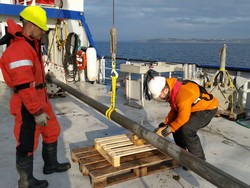Microbes and sub-seafloor carbon
Sea-floor microbes break down buried organic matter and drive complex mineralisation processes. Yet, it is unknown how the microbes obtain enough nutrients and metabolic energy in such a low-energy environment. The EU-funded DEEP CARBON FLUX (Energy and carbon food webs of the deep sub-seafloor biosphere) project examined the energetic and kinetic controls on metabolic processes in the sediments. The study focused on the role of small organic acids as key intermediates in microbial metabolism. The team also developed a new analytical technique that addressed the project aim, including 2D ion chromatography combined with mass spectrometric detection to quantify individual organic acids. The research involved sediment drilling at four marine sites, in the North and Baltic Seas and the Atlantic and Pacific Oceans. The drilling included two large international drilling operations conducted by the International Ocean Discovery Program (IODP, Exp. 337 and Exp. 347) and includes the world’s deepest cored borehole in the ocean floor down to ~2.5 km below seafloor (IODP Exp. 337). The team first developed the new analytical method for analysis of volatile fatty acids (VFAs) in marine samples. The technique was used to separate VFAs from chloride and sulphate ions, and then to separate individual VFAs. The technique allowed quantification of VFAs directly from seawater without further sample pre-treatment steps. Researchers employed the method to investigate pore water concentrations at the four study sites. Results indicated that concentrations were surprisingly constant, depending on biochemical zonation of nutrients and predominant microbial metabolic pathways. The study concluded that microbes control VFA concentrations. Threshold concentrations, below which acetate is not further depleted, reflect microbial cell physiological constraints. Thus, neither thermodynamics nor diffusion explain VFA turnover. Instead, cellular processes – such as membrane transport or activation of substrates – probably play an active role in pore water VFA concentrations. The processes affect available energy. However, the details may vary with different microbial communities. Based on the Pacific sediments, retrieved from the deepest cored borehole in the history of scientific ocean drilling (~2.5 km below seafloor), researchers further concluded that acetate and formate are abundant in the deep sediments and suitable for methane-based metabolism in that location. Acetate and formate are released during geological maturation of the source organic material providing a potential to support the deeply buried microbial biosphere over tens of millions of years. The project's outcomes illustrate the metabolic processes by which microbes in ocean sediments break down organic matter in order to gain energy. The work may ultimately find application also in waste disposal or recycling technologies and may contribute to estimate the impact of microbial generation of methane in the sediments impacting both, energy resources and natural greenhouse gas emissions.






